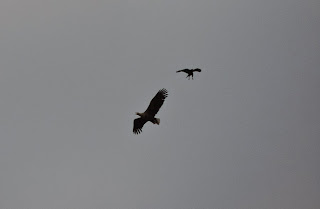Krakovski gozd is a large area of alluvial forest by the Krka river, holding the largest breeding densities of Middle Spotted Woodpecker
Dendrocopos medius and Collared Flycatcher
Ficedula albicollis in Slovenia. Most of the forest is composed of English oaks
Quercus robur, hornbeams
Carpinus betulus and alders
Alnus glutinosa in the associations
Pseudostellario-Quercetum and
Pseudostellario-Carpinetum. It is also the largest remnant of lowland alluvial forest in Slovenia and it encompasses a small virgin (primeval) forest with large quantities of dead standing (and fallen) trees. It is a paradise for hole-dwelling species and of great importance for the smaller fauna. In 1979 a new species of fungi for science was discovered in the virgin forest.
On Saturday I was there with a group of fellow biologists from university and we managed to see a considerable amount of biodiversity, including some of the specialties of the area. We started with the excellent observation of an adult
WHITE-TAILED EAGLE Haliaeetus albicilla soaring above the fields, close to the forest edge. A pair of these birds nests in the forest, which is one of the few known breeding sites of the species in Slovenia.
 |
| White-tailed Eagle Haliaeetus albicilla (with a Buzzard Buteo buteo in the 1st photo). |
In the forest the commonest bird songs heard for most of the day were those of Chaffinch
Fringilla coelebs, Cuckoo
Cuculus canorus, Blackcap
Sylvia atricapilla and
COLLARED FLYCATCHER Ficedula albicollis. Although the latter was relatively common, it was quite hard to get proper views as the foliage in the canopies was quite thick. Out of the 10-15 we heard, we managed to see two or three properly. Lovely little birds anyway.
 |
| Collared Flycatcher Ficedula albicollis (male). |
May is not a very good month for woodpeckers, but somehow we managed to see/hear at least 5 MIDDLE SPOTTED WOODPEKCERS Dendrocopos medius. One of them was observed collecting food on a forest road and then flying to its nest (below).
 |
| Middle Spotted Woodpecker Dendrocopos medius |
Otherwise we also heard one or two Great Spotted Woodpeckers
Dendrocopos major, but other Picids were silent. Of the most interesting species I'd also mention 3
Honey Buzzards Pernis apivorus, 4 Golden Orioles
Oriolus oriolus, 1 Wood Warbler
Phylloscopus sibilatrix, 2
Turtle Doves Streptopelia turtur, 2
Eurasian Treecreepers
Certhia familiaris (both treecreepers are present in the forest)
and 4
Bee-eaters Merops apiaster on migration over the forest. White Storks
Ciconia ciconia were also seen at different places around the forest, whilst the woodland edge produced Red-backed Shrike
Lanius collurio, Yellowhammer
Emberiza citrinella, Stonechat
Saxicola torquatus and Common Whitethroat
Sylvia communis. We weren't lucky with Black Stork
Ciconia nigra, that also breeds in the area.
Amphibians included several
Rana frogs (either
arvalis/temporaria/dalmatina) and Yellow-bellied Toads
Bombina variegata, while reptiles were represented by a Grass Snake
Natrix natrix.
 |
| Yellow-bellied Toad Bombina variegata - very common in the forest's pools. |
 |
| Flowers of Iris pseudacorus were very prominent in some places, giving a touch of colour to the overall green background. |
 |
| Views on the forest, with some large and old decaying trees present in good quantities. |
 |
| Dactylorhiza majalis on a forest glade. |
 |
| A wet meadow: paradise of sedges (Carex) and some rare, moist-loving plants like Epipactis nordeniorum (that we didn't see unfortunately) and Leucojum aestivum (below). |
 |
| Leucojum aestivum |
 |
| English Oak Quercus robur - this specimen is the second largest oak in Slovenia. |
And now to a completely different region: the Karst. In the past week I made small excursions on different sites in both dry grasslands and forest habitats. The most interesting of all the observations made was (again) a mammal - a
WILDCAT Felis silvestris that materialised some 50 metres away from me in the woodland where I was following the Middle Spotted Woodpeckers. Although I didn't see the Middle Spots this time, I had a nice consolation instead!
On the botany front, the most interesting was the "twitch" of a rare
plant I went to see on mount Slavnik (1028 m) in south-western Slovenia. See below for details.
 |
Pedicularis friderici-augusti - has its typical location (locus classicus) on mt. Slavnik. This means it was first described from specimens collected here. It was named in the honour of Frederick Augustus II, King of Saxony, when he visited this locality to see the plant. Interesting stories, behind little flowers!
|
 |
| The high-Karst grasslands on Slavnik, looking southwards. Full of Skylarks and flowers... |
 |
| Gentiana verna subsp. tergestina (named after the city of Trieste). |
|
 |
| Narcissus poeticus subsp. radiiflorus |
 |
| Skylark Alauda arvensis |
 |
| Dactylorhiza sambucina |
 |
| Astragalus monspessulanus subsp. illyricus |
 |
| Orchis purpurea |
 |
| Cephalanthera longifolia - common in woodlands at this time of year |
 |
| The view from Slavnik's south slopes to the Karst and the Gulf of Trieste (west/north-west). |
 |
| View from the top of Slavnik, looking south-east into wild Croatia. |
 |
| Paeonia officinalis - in full bloom at the moment on the Karst. |
 |
| Male Green Woodpecker Picus viridis |
 |
| Crataegus laevigata |
 |
| Asparagus tenuifolius |
 |
| Galeobdolon luteum (montanum) |
 |
| Lonicera xylosteum |
 |
| Moeringhia muscosa |
 |
| Morimus funereus - found three of these on a fallen tree. |
 |
| Anacamptis morio - the commonest orchid on the Karst. |
 |
| Pulsatilla montana |
 |
| European Green Lizard Lacerta viridis |











































